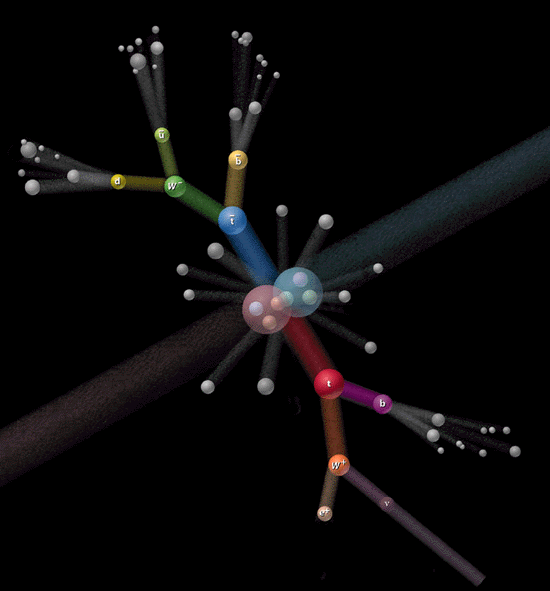
A quark is any of a group of subatomic particles believed to be among the fundamental constituents of matter. In much the same way that protons and neutrons make up atomic nuclei, these particles themselves are thought to consist of quarks. Quarks constitute all hadrons (baryons and mesons)--i.e., all particles that interact by means of the strong force, the force that binds the components of the nucleus.
According to prevailing theory, quarks have mass and exhibit a spin (i.e., type of intrinsic angular momentum corresponding to a rotation around an axis through the particle). Quarks appear to be truly fundamental. They have no apparent structure; that is, they cannot be resolved into something smaller. Quarks always seem to occur in combination with other quarks or antiquarks, never alone. For years physicists have attempted to knock a quark out of a baryon in experiments with particle accelerators to observe it in a free state but have not yet succeeded in doing so.
Throughout the 1960s theoretical physicists, trying to account for the ever-growing number of subatomic particles observed in experiments, considered the possibility that protons and neutrons were composed of smaller units of matter. In 1961 two physicists, Murray Gell-Mann of the United States and Yuval Ne`eman of Israel, proposed a particle classification scheme called the Eightfold Way, based on the mathematical symmetry group SU(3), that described strongly interacting particles in terms of building blocks. In 1964 Gell-Mann introduced the concept of quarks as a physical basis for the scheme, adopting the fanciful term from a passage in James Joyce's novel Finnegans Wake. (The American physicist George Zweig developed a similar theory independently that same year and called his fundamental particles "aces.") Gell-Mann's model provided a simple picture in which all mesons are shown as consisting of a quark and an antiquark and all baryons as composed of three quarks. It postulated the existence of three types of quarks, distinguished by distinctive "flavours." These three quark types are now commonly designated as "up" (u), "down" (d), and "strange" (s). Each carries a fractional electric charge (i.e., a charge less than that of the electron). The up and down quarks are thought to make up protons and neutrons and are thus the ones observed in ordinary matter. Strange quarks occur as components of K mesons and various other extremely short-lived subatomic particles that were first observed in cosmic rays but that play no part in ordinary matter.

Most problems with quarks were resolved by the introduction of the concept of color, as formulated in quantum chromodynamics (QCD). In this theory of strong interactions, developed in 1977, the term color has nothing to do with the colors of the everyday world but rather represents a special quantum property of quarks. The colors red, green, and blue are ascribed to quarks, and their opposites, minus-red, minus-green, and minus-blue, to antiquarks. According to QCD, all combinations of quarks must contain equal mixtures of these imaginary colors so that they will cancel out one another, with the resulting particle having no net color. A baryon, for example, always consists of a combination of one red, one green, and one blue quark. The property of color in strong interactions plays a role analogous to an electric charge in electromagnetic interactions. Charge implies the exchange of photons between charged particles. Similarly, color involves the exchange of massless particles called gluons among quarks. Just as photons carry electromagnetic force, gluons transmit the forces that bind quarks together. Quarks change their color as they emit and absorb gluons, and the exchange of gluons maintains proper quark color distribution.
Excerpt from the Encyclopedia Britannica without permission.